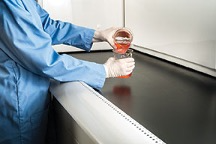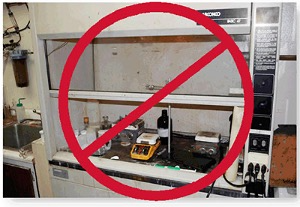General Safety
Fume Hoods
A fume hood is an enclosure designed to capture and contain harmful chemical vapors. These vapors are taken away from the user via exhaust ventilation typically by a roof mounted manifold ductwork system.
A fume hood is an enclosure designed to capture and contain harmful chemical vapors. These vapors are taken away from the user via exhaust ventilation typically by a roof mounted manifold ductwork system.
A laboratory can be a hazardous place to work. A fume hood is an engineering control that can help mitigate the hazards associated with use of chemicals in the laboratory. It is important that workers using a fume hood are aware of good practices so they do not compromise fume hood performance. To ensure safety, the user must be constantly mindful of what they are doing in order to experience the best containment.
The following practices/principles are important for safe use of a fume hood.
A fume hood is an enclosure designed to capture and contain harmful chemical vapors. These vapors are taken away from the user via exhaust ventilation typically by a roof mounted manifold ductwork system.
A biosafety cabinet is NOT a fume hood it is designed to protect he user from the hazards associated with use of biological materials not chemical hazards. Hazardous chemicals should not be used in a biosafety cabinet.
A laminar flow hood is primarily for protection of the material inside the hood, not the user.
 Operate at least 6 inches inside the fume hood behind the plane of the sash. This is important for safety as a good working practice, stated by industry standards such as ANSI/AIHA Z9.5. This means that any equipment placed in the fume hood should not be touching the airfoil along the front of the work surface.
Operate at least 6 inches inside the fume hood behind the plane of the sash. This is important for safety as a good working practice, stated by industry standards such as ANSI/AIHA Z9.5. This means that any equipment placed in the fume hood should not be touching the airfoil along the front of the work surface.
DO NOT BLOCK THE AIRFOIL! The airfoil is an important containment feature that should never be used to set a beaker upon or blocked. The holes in the airfoil allow air to sweep the work surface clean of any contaminated air, pushing it straight back to the baffle to exhaust.
When the fume hood is not in operation, close the sash! This is for safety, and may also contribute to energy savings for your laboratory. If your laboratory is working on a variable air volume (VAV) system, and includes sash sensors to control the volumetric flow (CFM) of the air, you can save your laboratory a significant amount of money per year in operating costs because when the sash is lowered, the volumetric flow is lowered to an accepted minimum.
Do not use your fume hood as a storage cabinet. Storage in the hood can lead to problems with the proper airflow in the hood. When chemicals are not in use, be sure to store them in cabinets appropriate for the chemical.

EHS performs annual function testing to ensure proper face velocity and operation of the fume hood. Hood operators should verify that a hood is working prior to beginning work within the hood. This can be accomplished via the hood’s monitoring system or by holding a tissue or KimWipe in the plane of the sash to verify that air is flowing into the hood.
The standard for airflow for the U is a face velocity, in the plane of the sash, with the sash at 18 inches of 80-120 feet per minute (fpm). This will be checked by EHS during annual testing a sticker will be applied to the side of the hood indicating the date of the test as well as the measured face velocity. EHS will also check for cross drafts which may affect proper fume hood operation and perform a “smoke” test to visualize the airflow within the hood to check for any flow problems.
Should a fume hood need repair contact facility operations at 801-581-7221. If you would like to have your fume hood tested for proper air flow, contact EHS at 801-581-6590 or email to questions@ehs.utah.edu.
Explore a wealth of information, guidelines and tools designed to foster a safe campus environment.